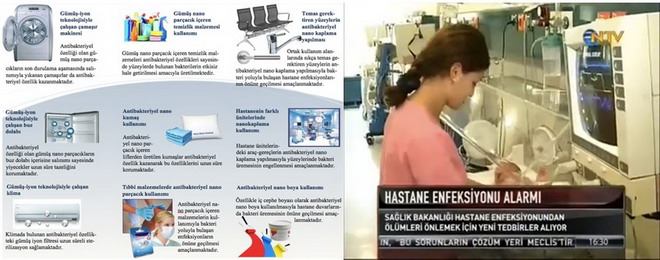Engagement
Based on the overarching scenario, the module starts with a video of news broadcasted on a local TV channel. The news points out the increase in the number of cross infections in the hospitals, and its threat to human health. Right after the video, teacher initiates a discussion about the possible reasons of the spread of diseases stemming from the cross infection.
Then the teacher points out a brochure taken from a hospital's public relations department, the brochure includes a group of researchers’ suggestions for using nanosilver (Silver nanoparticle) products such as towels, linens, kitchenware, door handles, etc. According to scenario, the hospital administration assigns a committee to decide whether this hospital should use these nanosilver products or not. Then students are asked to identify who should take part in this committee and why. Students specifically discuss about the risks and benefits of using nanoparticles in the health sciences, in daily life products, and in the public spaces.

The second lesson of the module is about the concepts of size and scale that is one of the nine big ideas of nano scale science and engineering (Stevens et al., 2009). Students make some predictions about changing interactions with the environment, when their size becomes a thousand times bigger and a thousand times smaller. Then, they watch two videos including some scenes from two movies, (Honey, I Shrunk the Kids (1989) and Gulliver’s Travel(2010)) to visualize two different situations faced as a result of being too small and too big as a human being. This lesson also includes engagement of 5E as the students are introduced to a fundamental concept of nanoscience through various activities.

The third and fourth lessons of the module are about the size-dependent properties and tools and instrumentation, respectively, which are also among the nine big ideas of nanoscale science (Stevens et al., 2009). Students design and conduct an experiment to explore whether the size of the medical tablets affect its absorption and release time, and they observe the bacteria on the agar cubes under different tools and instruments such as optic microscope, magnifying glass, and SEM.

Exploration & Explanation
The fifth and sixth lessons of the module are about testing antibacterial effect of silver nanoparticles and testing the durability of the antibacterial effect of a textile nano-product against washing. Students synthesize silver nanoparticles and perform the experiment they designed before to explore whether silver nanoparticles have anti-bacterial effect or not. They observe the growth of bacteria around a dry filter paper, a water-soaked filter paper and two silver nanoparticle solution-soaked filter papers of size 2x2cm on a agar petri dish on a daily basis during 3-5 days and take photographs of the plates. Then, they compare these pictures with the previously taken SEM images of the same experiment.

Then, students design an experiment to search for whether the anti-bacterial effect of a product including nanoparticles changes with washing or not. They wash 3-5 times a textile product including nanosilver particles. Then, samples of the wash waters and the textiles are sent to a laboratory to test the amount of silver ion remaining on the textile and released into water. Afterwards, students are given a data sheet from a laboratory analysis done for the same product from 1 to 10 washing analysis. Students are asked to interpret the data and discuss about the possible outcomes of the changing amount of silver ion regarding the ethical issues.

Elaboration
In the seventh lesson, students search for the uses, advantages and risks of other nanoparticles such as gold, silica, and iron nanoparticles. They read scientific articles about these nanoparticles, and they view some videos about the usage of them. Then, they prepare a presentation and share their ideas as a group.

In the 8th lesson, as part of the overarching scenario, students evaluate a report on risks and benefits of silver nanoparticles submitted to hospital’s administration, and they decide if the hospital should accept or decline using silver nanoparticles by developing valid arguments.
Exchange
Students develop an exhibit product related to content of the module in groups. They display these products first in their schools, then at a science center. In addition, throughout the module, students discuss and share the results of experiments they conduct with each other, and they argue about many controversial RRI issues. They share ideas both verbally (e.g., oral comments during discussions presentations) and visually (presentations, drawings, diagrams, and graphs).

Evaluation
Students are provided specific questions about the concepts they learned each lesson, and they are asked to write reflective journal entries at the end of the each lesson of the module and upload these journal entries to Edmodo. In addition, an open-ended conceptual questionnaire referring to module’s objectives will be given in the beginning and at the end of the module.









